The American desire to dominate the Western Hemisphere through the political and economic invasions of Latin American nations, the incessant economic stagnation and the weak, corrupt political institutions - led to the naissance of the strong anti-American sentiment and the desire among the local population to achieve both political and economic freedom, as well as comprehensive civil rights.
An example given by the Cuban revolutionaries in 1959 inspired others in Latin America to liberate themselves from Yankee imperialism.
Nicaragua was one of the inspired nations that stood up for its rights.
The American National Myth
The Cuban and Nicaraguan revolutionary paths, despite being twenty years apart, stem from a strong source of desire to free their nations from overt American domination .
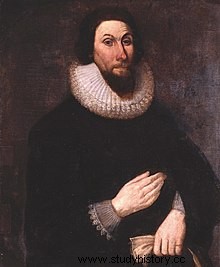
To understand the reasons behind such US foreign policy in Latin America, it is necessary to consider the symbolic history of American imperialism .
The oldest American myth claims that Puritan lawyer John Winthrop , while leading the first major immigration from England to North America in 1630, proclaimed that "they were on a journey that God himself not only approved, but in which he participated." [1]
Thus, they call themselves a chosen people In a nation created by and for God, the Puritans decided that America must be a moral example of the world: "Because we have to consider that we should be like a City on a Hill , the eyes of all men are upon us. ”[2]
Brother Winthrop's ideals are reflected throughout American history.
Loren Baritz explores the potential of the national myth , in combination with sufficient national power, to impose on a nation its will for the rest of the world. In fact, "American nationalism in its purest form thinks of the world as populated by frustrated or potential Americans" [3], provoking dangerous solipsistic thinking , where the American self is projected onto other countries and cultures.
The Importance of Metaphors for the American Power Projection

The Cuban War of Independence 1895-98 did not seem to satisfy the American 'view' of Cuba's future; the future of an independent nation, not subject to regional dominance.
This drew the Americans into the Spanish-American War of 1898 and gave rise to American "popular belief in the deployment of power as a matter of moral discharge ». [4]
By portraying themselves as protectors of Cuban freedom and liberty - the pure American qualities - against Spanish rule, Americans justified warfare.
Thus, the intervention in Cuba was celebrated by Woodrow Wilson as "an impulse of human indignation and pity - because we saw at our doors a government that was not conscious of justice or mercy, contemptuous in its respective practices of the principles we professed to live by." [5]
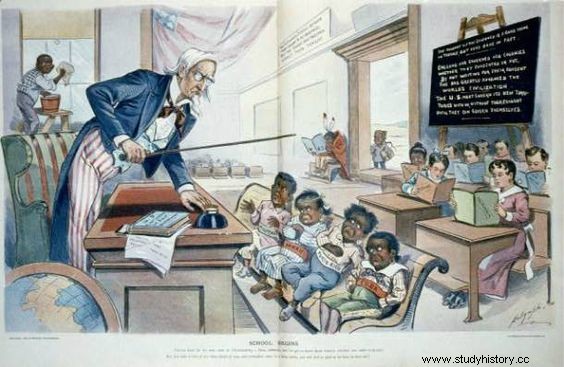
Through the implementation of various metaphors , Hidden Americans "the contradictions that are often created in the pursuit of national interests in the guise of the pursuit of national ideals." [6]
The usual metaphor for a adult-child relationship often portrayed the United States as a dominant figure - an adult guide - over the stupid, uncivilized children represented by the Latin American countries.
The Spanish defeat during the Spanish-American War proved its incompetence in exercising that authority as an adult, thus 'forcing' the righteous Americans to assume the burden of greatness " [7] by preparing the Latin American countries for adulthood by 'civilizing' them through the imposition of American ideals and morals.
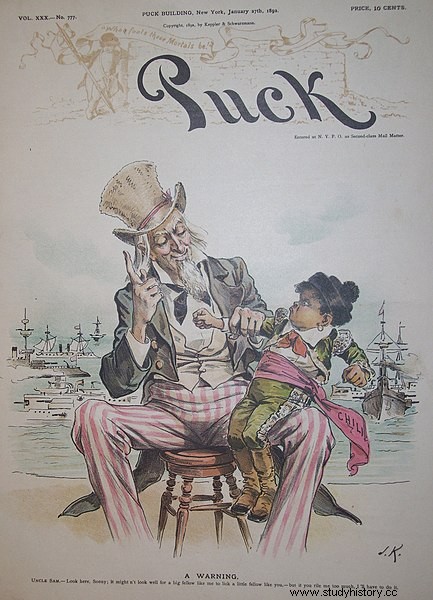
As in all adult-child relationships, an adult has full moral authority to punish a misunderstood child.
Theodore Roosevelt for example, approved the idea of intervention in the affairs of the Latin American country in case if the latter did not act in accordance with American interests:"if a South American state behaves badly towards any European country, let the European country beat it." [8]
Therefore, someone Cuban or Nicaraguan national action not approved by the United States used to disappoint the latter and justify its intervention.
The roots of anti-American sentiment in Cuba
In Cuba, the biggest disappointment for the United States was the Cuban Revolution of 1959.
Its aftermath- Fidel Castro The Marxist-Leninist political position was branded a 'betrayal' by the United States 
In an atmosphere of controversial ideological and political tensions for world domination between the communist Soviet Union, the liberal United States and their satellite states, divided on the Iron Curtain , there was a constant fear of the domino effect .
It was believed that if one country west of the Iron Curtain fell under the influence of communism, the other countries in the region would follow its leadership (similar to dominoes), thus leading to the fall of the American state and the rise of communism in the world.
Thus, the Cuban has turned left and the alliance with the Soviet Union greatly undermined the American sense of security.
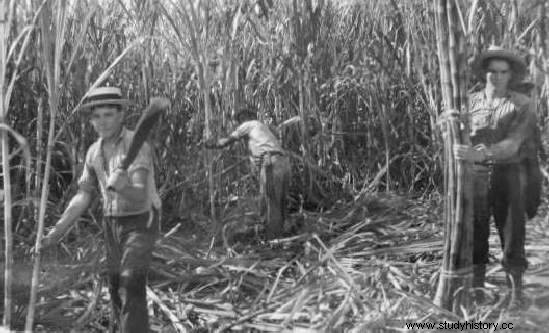
However, it would be reasonable to note that the Americans themselves contributed (either consciously or not) to the result they hated so much .
Cuban national sentiment was not invented by Fidel Castro, as they were already part of an older Cuban political culture "to which Cuban leaders were heirs and in which they themselves had been formed." [9]
Historically, Cuba had a perfect environment for sugar production, which became the country's main source of income, and "in 1850 Cuba produced a third of all the sugar in the world." [10]
Despite remaining a Spanish colony, Cuba became too dependent on trade with the United States :"Seventy percent of Cuba's trade was with its neighbor to the north, and three quarters of it was in sugar." [11] The economy stagnated due to the four-month sugar harvest, leaving the majority of the population unemployed for the rest of the year.
Besides the Cuban monoculture export economy which was extremely dependent on US markets, "favored the status of US-produced goods in the Cuban market limited the opportunities for Cuba's economic diversification and development." [12]
In total, the Americans owned eighty percent of the country's assets, forty percent of the sugar industry, while in 1958, American investment in Cuba reached one billion dollars. [13]
After being exploited under two masters, Cuba appeared vulnerable and oppressed.
Jose Marti led the Cuban struggle for liberation from both Spanish colonization and American economic dominance. He was 
killed while fighting for Cuban independence on May 19, 1895, and then seen as a national hero. However, the dream of a politically and economically free Cuba was abandoned when the United States intervened in the Spanish-American War in 1898, since its "economic and geopolitical interests dictated constant supervision and close political control over the island." [14]
In exchange for the American promise not to annex Cuba in 1901, the Platt Amendment was added to the Cuban constitution. Under this law, the United States "had the right to intervene to preserve Cuban independence, [and] maintain a government sufficient for the protection of life, property and individual liberty" [15], and thus makes Cuba a US protectorate .
The subsequent grassroots mobilizations such as radical student movements and urban uprisings led to the repeal of the Platt Amendment in 1934 as part of 'Good Neighbor Policy' aimed at creating new economic opportunities through trade agreements.

However, this policy did not appease Cubans against the United States, since the US staged assassination attempt on Constitutional President Ramon Grau San Martin in 1933, the US government placed the very unpopular anti-communist Fulgencio Batista to power.
Batista's support base was anchored in the army, and thus he could not have cared less about public opinion and the Cubans who despised him for his many human rights violations and the abolition of important civil liberties.
However, the United States continued to provide economic, military, and logistical support to Batista, which naturally led to hatred of American domination of Cuba.
The situation was clearly blown out of proportion.
The roots of Nicaragua's anti-American sentiment
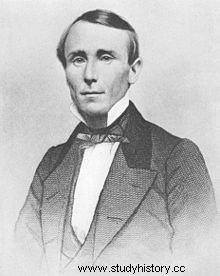
In Nicaragua, the anti-American sentiment has largely contributed to the spark of radical nationalist sentiment.
Unlike sugar-rich Cuba, Nicaragua had few natural resources and its "rugged terrain meant that only 10 percent of the land was cultivated." [16]
In 1856, the American traveler William Walker settled and then took over the country as president. His abusive policies, such as the restoration of slavery, loyalty and English as the only official language, forced the Nicaraguans out of the country.
Although Walker was not funded by the US government, Nicaraguans remember him as a symbol of the first US attempt to control his country .
Walker's negative reputation and his affiliation with the Liberals resulted in a conservative-dominated policy for the next thirty years.

In 1893, the Liberals finally won the election with Jose Santos Zelaya , which opposed the comprehensive US economic control

and aimed to extend Nicaragua's sovereignty over the British-controlled Atlantic coast.
As with Martin in Cuba, the Americans were naturally dissatisfied with Zelaya's political views , and in 1909 he intervened to remove him from power. Zelaya was replaced by conservative pro-American Adolfo Diaz , who in 1911 invited American Marines to Nicaragua to prevent Zelaya's return and to guarantee US economic and geopolitical interests.
This led to a long period of service in Nicaragua by the US Marines (1911-1933).
The Liberal Party, in turn, initiated a revolution against the Diaz regime. Fearing a long-term military complication, the United States sent a special envoy Henry Stimson to Nicaragua to sign the Espino Negro Pact of 1927 , which led the United States to oversee the first fraud-free election , so that the Liberal Party can win.

A liberal general, Augusto Cesar Sandino , who was dissatisfied with the US incursion, demanded "complete withdrawal of the navies, respect for Nicaragua's national sovereignty and a government that represented the interests of the majority." [17]
He formed a guerrilla army and led a five-year campaign against U.S. Marines and the Nicaraguan National Guard . The Sandinistas provided schools, agricultural assistance, and, unlike the U.S. Marines, established close ties with the locals on the Atlantic coast.

The popular support helped the Sandinistas withdraw the Marines, who were then replaced by the US-trained National Guard, led by Anastasio Somoza Garcia . Somoza, like Batista, was pro-American and spoke English fluently.
In 1934, Sandino, as the only person with sufficient popular support capable of preventing Somoza's seizure of power, was assassinated.
In 1936, Somoza took over the government and manipulated the constitution to establish "his personal empire as a family dynasty" [18], making him and his two sons serve as presidents for a total of 43 years . Political repression, the abolition of civil rights and massacres were common features of the presidency.
Furthermore, Somoza, like Batista, was fully subject to US wishes, allowing, among other things, "the US military to use Nicaragua as a base for attacks on Jacobo Arbenz government of Guatemala in 1954 and for the invasion of the Bay of Pigs in Cuba. "[19]
It seemed that as long as American imperial interests were served, US governments were willing to cooperate with authoritarian leaders. Therefore, American commercial and geopolitical interests and, with the advent of the Cold War, the relentless fear of the communist takeover of fidelist warriors inspired by the Cuban Revolution of 1959 , fed the American preference to 'assign' dictators instead of the democratic leaders of the Latin American countries.
The rise of national resistance in Cuba
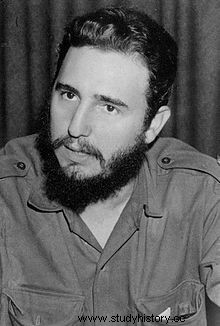
The constant repression, discrimination and human rights violations inflicted by these dictators led to an increase in national antagonisms.
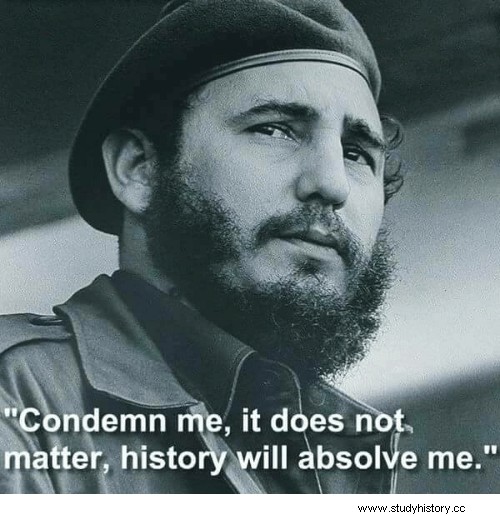
Fidel Castro failed foco attack on the barracks of the Moncada army in Santiago, Cuba on July 26, 1953, which he believed would produce the shockwaves sufficient for the popular uprising against the Batista regime, took him to court.
His defense speech in the courtroom from 1953, known as History Will Solve Me , proclaimed the "five revolutionary laws" , Such as:
- reintroduction of the Cuban constitution,
- land rights of those "who have packages of five or fewer" caballerias "land" [20],
- industrial workers' right to a 30% share of all large enterprises,
- all plants' right to 55% share of sugar production,
- and confiscation of all assets acquired through fraud under previous regimes.
Castro successfully made his defeat a call for revolution , declaring that "the problems of the republic can only be solved if we dedicate ourselves to fighting for that republic with the same energy, honesty and patriotism that our liberators had when they created it." [21]
While serving his prison sentence, Castro was inspired by Marti's desire to achieve both political and economic independence.
Castro was released from prison in 1955 and deported to Mexico, where he founded the 26 th July Movement (M-26) Organization and began preparations for an armed uprising.

In December 1956, the yacht became Granma with Castro and 82 revolutionaries returned to Cuba. Due to the rough seas, however, the arrival of the yacht did not coincide with the urban underground resistance led by Frank Pais .
Thus, Pais' revolt and Castro's guerrilla force, which landed a few days later, were well crushed by Batista's troops, leaving only eighteen warriors alive.
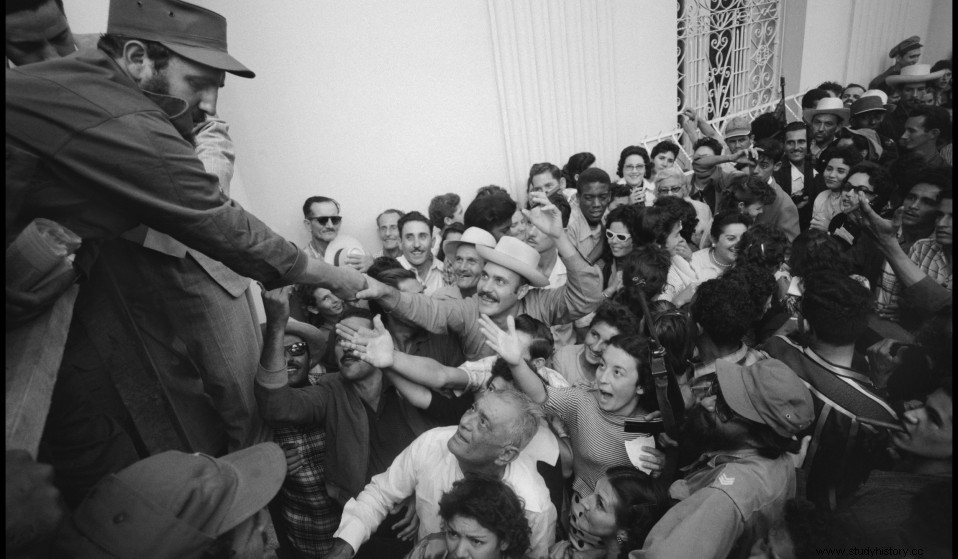
Here the importance of local grassroots mobilizations and support of students, farmers and city dwellers should not be overlooked.
It is likely that the M-26 would never have regained strength after Granma attack, it would not have been for the local farmers who joined the fight. Similarly, the urban underground diverted Batista's attention to students and middle-class residents and away from the village guerrillas, thus allowing Castro to prepare the village warriors for future victorious attacks, leading to Batista's escape from Cuba on January 1, 1959.
Fidelism versus communism
The successful Cuban revolution of 1959 gave birth to fidelismo -a new socio-political movement in Latin American countries, named after its leader Fidel Castro.
Fidelismo brought the dramatic intensification of political situations to other Latin American countries, since it created the attitude that revolution should be pursued immediately .

This contradicts the famous communist notion that the country had to achieve a certain level of capitalist economic development for a socialist revolution to take place.
The Communists claimed that Cuba's economically backward people would not succeed against the Batista regime, and they did not (first) support the revolution.
It shows that despite following Marxist teachings, Castro's Cuba was not a 'USSR-style' communist , despite what the official US foreign policy proclaimed.
Castro's response was the first statement from Havana , 1960, in which he denied the Soviet or Chinese intention to "use Cuba's political and social situation ... to break the continental unity and endanger the hemisphere." [22] He also proclaimed that the revolution was " Cuba firm response to the crimes and mistakes committed by imperialism in America "[23] thus China and the Soviet Union could not be blamed.
Rise of National Resistance in Nicaragua
The successful Cuban uprising "created a mystery about guerrilla warfare" [24], making it a popular enterprise, and emphasizing the importance of comprehensive social and political reforms, such as the famous First Declaration of Havana 's ten-point program, which included national sovereignty, social justice and education.
Thus, fidelismo inspired other Latin Americans to try to bring about social and political change in their societies in a variety of ways.
Nicaragua was no exception.


Convinced that they could also establish a guerrilla movement to overthrow the Somoza regime and replace it with a socialist government, Carlos Fonseca Amador and Tomas Borge Martinez formed the Sandinista National Front (FSLN) in 1961.
The Socialist Party of Nicaragua , just like Cuban communists who criticized Castro's M-26 movement, condemned the FSLN as too early and too idealistic, and chose to wait for appropriate economic conditions for a socialist takeover.
After visiting Cuba in July 1959, however, Fonseca realized that the economic downturn in the country was not a deterrent to revolutionary action.
Similar to Castro's foco tactics , The FSLN believed that a small guerrilla army could trigger a broad revolution.
In 1967, however, the Sandinistas ran into the police, who slaughtered all but fifteen warriors. Again, the Sandinistas, like the fidelity warriors, could only regroup because of their close cooperation with local farmers and workers, which led them to reconsider the validity of the foco approach and instead aim to build peasant and urban connections.
The Historical Program of the FSLN , 1969 outlined a thirteen-point program, including land for the peasants, labor laws, the liberation of women, the end of discrimination against ethnic minorities, and the spread of education, which taught “new generations [the] eternal gratitude and reverence for those who have fallen in the struggle. to make Nicaragua a free homeland. [25] Sandinistas also enjoyed a high degree of support from indigenous peoples such as Mistitu , since they both drew on their actions as part of the historical opposition to colonial domination.
Unlike the fidelist warriors in Cuba, the Sandinistas did not necessarily aim to achieve a Marxist revolution, but "a solid grounded in their own historical reality and experience. "[26] For this reason, Augusto Cesar Sandino was everywhere represented as a national hero and a symbol of revolution (his name (letter S) was also added to FLN).
Also, the Nicaraguan Revolution of 1979 became one of the first to openly accept the role and contributions of the church in overthrowing the dictatorial regime. Instead of seeing religion as a false consciousness, as Marxists in Cuba did, "the Sandinistas believed that religion could be used to raise people's revolutionary consciousness." [27]
The liberation theology , in contrast to traditional Christian theology, gave hope to the oppressed and made people realize that they must take responsibility for their own fate , and thus represents "a historic turning point in the Catholic Church's attitude to popular movements for social justice." [28]

Today, unfortunately, many equate the Nicaraguan Revolution with oppression, as that struggle against the Somoza dynasty has only brought a new, equally authoritarian group of people in power, who have slowly reintroduced everything the nation has fought against. [29]
Moses Hassan , a former rapporteur in Managua and a former fighter from Sandinista, believes that the current Nicaraguan president, Daniel Ortega , has done even worse things than Somoza. [30]
He recalls that during Somoza administrations, children were not as indoctrinated about the glory of the regime as they are now, since "from almost the first moment of the triumph in 1979, the cult of the Sandinista front was already implanted. Portraits everywhere. Propaganda in school books. the children sandinist flags and send them out to parade in activities organized by Ortega. "[31]
Most importantly, per Hassan, in contrast to the current administration's total invalidity of the opposition and the change of power, which includes the recent imprisonment of 26 bourgeois and political leaders (including six potential presidential candidates) [32] The Somosa government allowed some criticism and opposition from its ministers and politics. He also mentions that the Somoza administration, unlike the Ortega government, would never have followed the opposition leader's family [33], as well as "knowing exactly who stole and how much they stole" [34] - that is, corruption was more checked.
Hassan thus concludes that "the Ortega regime is an updated version of Somoza, corrected and improved, with much more weapons, much less respect for human rights and a greater degree of corruption." [35]
the conclusion
American imperialism, rooted in the traditional myth of the city on the hill , given Americans moral validity to expand its power and influence throughout the world.
The adult-child metaphor allowed Americans, under the guise of high morale of 'parental responsibility' for the 'uncivilized' nations of the South, to pursue their imperialist economic and geopolitical aspirations and ultimately to dominate the world.
US support for pro-US dictatorial regimes in Latin American countries before you The Cold War allowed Americans to dominate their economies and easily extract resources.
Under The incessant clash of the Cold War between the Soviet Union, the United States and their satellites, the Americans developed a new fear of communist takeover. Feared by the domino effect on the west side of the Iron Curtain, they supported the dictatorial regimes that were seen as more resilient to the communist threat.
The Democratic nominees, who could easily be undermined by the socialist guerrilla fighters, were usually removed from office or assassinated through US-sponsored actions.
The ultimate anti-American sentiment, the dependence on sugar agriculture, which created enormous unemployment for eight months of the year, and the destroyed political system - stimulated everything to the growth of the first small guerrilla forces that aimed to bring justice back to Cuba.>
Through their social change programs, they were able to receive support from all sections of society, including peasants, the urban middle class and even some elites.
The successes of the Cuban Revolution of 1959 and its fidelismo movement inspired people in other countries such as Nicaragua to fight for their rights (whether or not it led to desirable results).
Bibliography:
- Baritz, Loren. "God's Land and American Knowledge." In Backfire:A story about how American culture led us into Vietnam and made us fight the way we did 19-54. New York:William Morrow and Company, 1986.
- Becker, Marc. The Latin American Revolutions of the Twentieth Century . Lanham; Boulder; New York; London:Rowman and Littlefield, 2017.
- Fidel Castro, History Will Solve Me . Bungay, United Kingdom:Richard Clay [The Chaucer Press], 1968.
- Fidel Castro, The Havana Declaration . np:26 th July movement in the United States, 1960.
- Frente Sandinista de Liberacion Nacional, Historical Program of the FSLN. Managua, Nicaragua:Department of Propaganda and Political Education of the FSLN, 1984; trans. by Marc Becker.
- Hale, Charles R. "Nation Building, Resistance and Hegemony:Historical Roots of Ethnic Conflict, 1894-1960." In Resistance and Opposition:Miskitu Indians and the Nicaraguan State, 1894-1987 37-59. Stanford, CA:Stanford University Press, 1994.
- Ramirez, Hans Lawrence. "Moises Hassan:The Ortega Regime is an Updated Version of Somoza." Havana Times , July 25, 2021. https://havanatimes.org/interviews/moises-hassan-the-ortega-regime-is-an-updated-version-of-somoza/.
- Rojas, Rafael. "Nicaragua:Where Revolution is Equal to Oppression." Havana Times , July 21, 2021. https://havanatimes.org/opinion/nicaragua-where-revolution-is-equated-with-repression/.
- Roosevelt, Theodore to Herman Speck von Sternberg, July 12, 1901. In Theodore Roosevelt's letter. Cambridge, Messe, 1954.
- Perez, Louis A., Jr. Cuba in the American Imagination:Metaphor and the Imperial Ethos . Chapel Hill:University of North Carolina Press, 2008.
- Flat changes , 1903.
- Wright, Thomas C. Latin America in the Era of the Cuban Revolution:Revised Edition . Praeger Publishers, 2001.
Notes:
[1] Loren Baritz, "Land of God and American Knowledge," in Backfire:A Story of How American Culture Led Us Into Vietnam and Made Us Fight the Way We Did (New York:William Morrow and Company, 1986), 26
[2] Baritz, Ibid, 26
[3] Baritz, Ibid, 31
[4] Louis A. Perez, Jr., Cuba in the American Imagination:Metaphor and the Imperial Ethos (Chapel Hill, 2008:University of North Carolina Press), 5
[5] Perez, Ibid, 8
[6] Perez, Ibid, 258
[7] Perez, Ibid, 258
[8] Theodore Roosevelt to Herman Speck von Sternberg, July 12, 1901, in Theodore Roosevelt's letter (Cambridge, Mass. 1951-54)
[9] Perez, Ibid, 274
[10] Marc Becker, The Latin American Revolutions of the Twentieth Century (Lanham; Boulder; New York; London:Rowman and Littlefield, 2017), 108
[11] Becker, Ibid, 109
[12] Wright, Ibid, 5
[13] Becker, Ibid, 110
[14] Thomas C. Wright, Latin America in the Era of the Cuban Revolution:Revised Edition (Praeger Publishers, 2001), 4
[15] Flat changes , 1903
[16] Becker, Ibid, 161
[17] Charles R. Hale, "Nation Building, Resistance and Hegemony:Historical Roots of Ethnic Conflict, 1894-1960," I Resistance and Opposition:Miskitu Indians and the Nicaraguan State, 1894-1987 (Stanford, CA:Stanford University Press), 53
[18] Becker, Ibid, 162
[19] Becker, Ibid, 163
[20] Fidel Castro, History Will Solve Me (Bungay, UK:Richard Clay [The Chaucer Press], 1968), 39
[21] Fidel Castro, History Will Solve Me (Bungay, UK:Richard Clay [The Chaucer Press], 1968), 40
[22] Fidel Castro, The Havana Declaration (np:26 th July Movement in the United States, 1960), 2
[23] Castro, Ibid, 2
[24] Wright, Ibid, 1
[25] Frente Sandinista de Liberacion Nacional, Historical Program of the FSLN (Managua, Nicaragua:Departmento de Propaganda y Educacion Politica del FSLN, 1984; overs. Av Marc Becker), 4
[26] Becker, Ibid, 170
[27] Becker, Ibid, 173
[28] Becker, Ibid, 174
[29] Hans Lawrence Ramirez, "Moises Hassan:Ortega -regimet er en oppdatert versjon av Somoza," Havana Times , Juli 25, 2021, https://havanatimes.org/interviews/moises-hassan-the-ortega-regime-is-an-updated-version-of-somoza/.
[30] Ibid.
[31] Ibid.
[32] Rafael Rojas, "Nicaragua:Hvor revolusjon er lik med undertrykkelse," Havana Times , Juli 21, 2021, https://havanatimes.org/opinion/nicaragua-where-revolution-is-equated-with-repression/.
[33] Ramirez, ibid.
[34] Ibid.
[35] Ibid.
